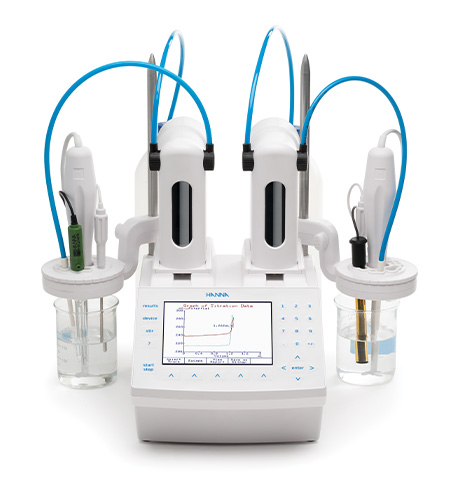

Hanna
Photometric
Electrodes
Photometric
Electrodes
for Use with our
Automatic Potentiometric Titrators
Automatic Potentiometric Titrators
These photometric probes are used with a potentiometric titration for equivalence end point detection of colorimetric reactions. These probes are available in 4 different wavelengths from 470 nm to 625 nm and have a universal BNC connector that is used as a potentiometric input on Hanna titrators and autosamplers.
About
Photometric
Electrodes
Photometric
Electrodes
pH, ORP and ISE electrodes are commonly used in potentiometric titrations. These probes produce a voltage that changes as a titrant is dosed into the sample being analyzed.


The Hanna family of photometric probes use the principle of absorbance at a specific wavelength to identify the equivalence point of a titration with the use of a color indicator. The color change of a solution causes a sharp change in the absorbance which also causes a sharp change in the mV response.
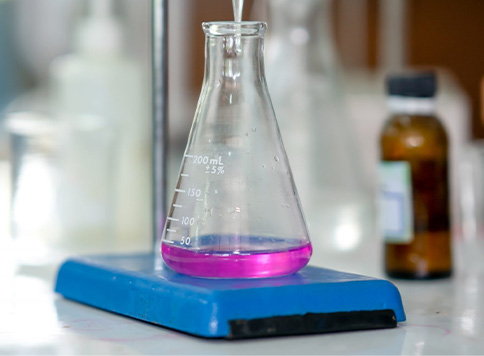

It is common for a complexometric titration to end in a flat mV response. Using the Hanna potentiometric titrator it is possible to program the meter to use the first derivative as the end point. This program is ideal since when a color indicator is used the color change occurs very distinctly.
The use of a photometric probe for potentiometric titration can be used for a variety of complexometric titrations including calcium and magnesium water hardness and iron, aluminum and calcium in cement materials testing.
The photometric probe is also ideal for non-aqueous titrations such as Total Acid Number (TAN) and Total Base Number (TBN) of petroleum products due to its advantages over a standard pH electrode.
With the photometric probe there is no fill solution to change in order to be compatible with a non-aqueous sample and there is no pH sensor to foul.


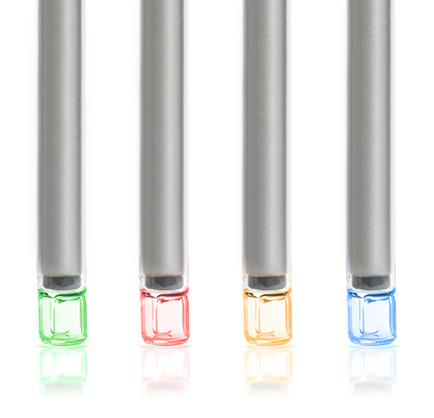

Features
Reflective measurement
Allows for a high color sensitivity in a compact design. Each probe has an LED at a specific wavelength that shines light through the sample and reflected back by a platinum mirror sealed in glass. The reflective measurement has a fixed path length and allows for a high color sensitivity in a compact design.
Open cell design
The probes’ open cell design that allows for the solution to pass through with the use of a stirrer.
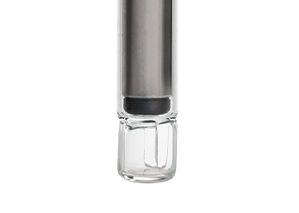

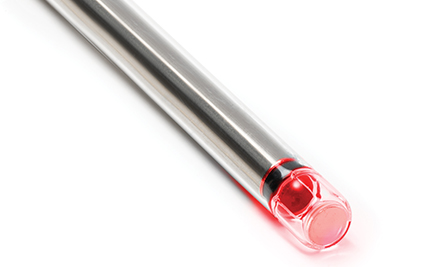

Glass body
All of the photometric probes have a glass body that offers excellent chemical resistance. The body of the electrode is 12 mm in diameter and fits easily into sampling beakers.
Universal
BNC connector
BNC connector
Hanna Photometric Electrodes feature a universal BNC connector that is used as a potentiometric input on Hanna titrators and autosamplers.




Temperature compensation
Drift from variances in temperature are automatically compensated.
LED brightness trimmer
If needed, a trimmer is provided in the head of the eletrode to adjust the led output value.


HI90060x
Series of Photometric Electrodes
All Hanna Photometric Electrodes have the same design but vary in the wavelength of light used for the photometric analysis.
Total
Base
Number (TBN)
Base
Number (TBN)
Total Base Number (TBN) is a measurement of basicity that is expressed in terms of the number of milligrams of potassium hydroxide per gram of oil sample (mg KOH/g).
TBN is an important measurement in petroleum
products, and the value varies depending on its application.
– Used as a measure of the breakdown of petroleum and petroleum additives
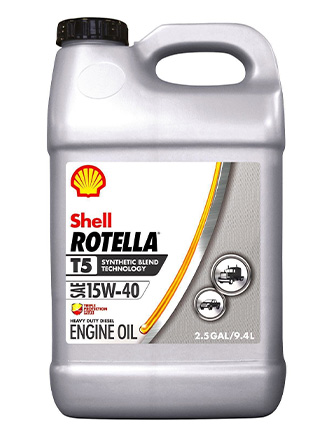

TBN generally ranges:
- 6–8 mg KOH/g in modern lubricants
- 7–10 mg KOH/g for general internal combustion engine use
- 10–15 mg KOH/g for diesel engine operations
- 15-80 mg KOH/g for marine grade lubricants
The TBN values are typically designed higher to increase the operating period under harsh operating conditions, before the lubricant requires replacement.
Can be determined photometrically using the HI900601 at 525 nm
- Indicator used is methyl orange
- Titrated with 0.1 M HCl in 2-propanol until transition from red to yellow


Total Acid Number (TAN)
The total acid number (TAN) is a measurement of acidity that is determined by the amount of potassium hydroxide in milligrams that is needed to neutralize the acids in one gram of oil.
- It is an important quality measurement of crude oil.
The TAN value indicates to the crude oil refinery the potential of corrosion problems. It is usually the naphthenic acids in the crude oil that cause corrosion problems. This type of corrosion is referred to as naphthenic acid corrosion
(NAC).
TAN values may also be useful in other industries where oils are used as lubricants to determine oxidation and the subsequent corrosion risk to machinery.TAN merely measures the corrosive acids present in the fluid, and will increase over time as an indication of the deterioration of the fluid.
Acid crude oil means that the acid number is >0.5mg KOH/g, and high TAN crude means that the acid number is >1.0mg KOH/g.
Generally, an acid number of anything over 1 is considered high.
Can be determined photometrically using the HI900602 at 625 nm
- Solution is titrated with KOH to the p-naphtholbenzein green-brown end point
- Used on new oils and oils that are not excessively dark


Instruments that Conform
to Industry Standards!
to Industry Standards!
HI932
Advanced Automatic
Potentiometric Titrator
Potentiometric Titrator
The HI932 Advanced Automatic Titrator is the answer to your advanced titration needs. Titrate for a variety of published methods at the push of a button, as well as perform direct measurements and back titrations for complex samples.
- Total Acid Number (TAN)
- Total Base Number (TBN)
- ASTM D664
- ASTM D2896
- ASTM D4739
- ASTM D3227
- ASTM D1159
- Salts & Surfactants
For those that require greater automation, pair your HI932 with the HI922 Autosampler for the most accurate results with the least amount of effort.
- Small footprint so you can fully optimize your benchtop and increase productivity.
- Reduce downtime and increase efficiency when you perform multiple analyses linked in sequence.
- Works seamlessly with the HI922 Autosampler for automation of up to 18 samples.
HI922
Autosampler
Author:
Nives Vinceković Budor
mag.ing.chem.ing.
Nives Vinceković Budor
mag.ing.chem.ing.


With Great Product Come Great Results





